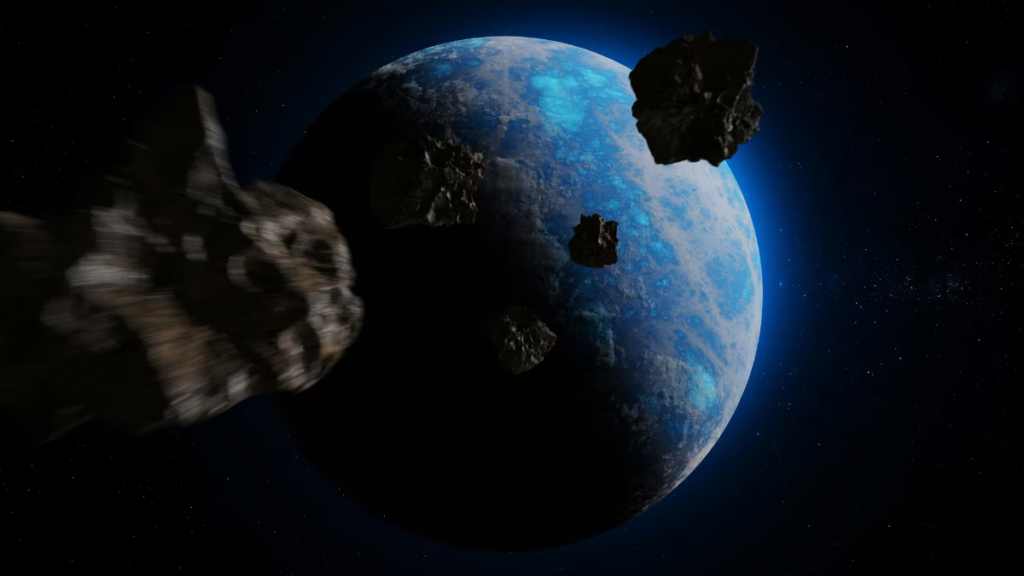NASA’s Jet Propulsion Laboratory has recently announced that two asteroids, named 2020 GE and 2024 RO11, are set to pass by Earth on September 24, 2024.
This alert has raised excitement among the astronomy community and space enthusiasts, as these asteroids will come relatively close to our planet. However, there is no reason for concern, as NASA has confirmed that these objects will safely pass by without posing any threat to Earth.
NASA’s Monitoring of Near-Earth Objects (NEOs)
NASA plays a critical role in monitoring Near-Earth Objects (NEOs), which include asteroids and comets that come close to our planet.
Read ; NASA Chooses Iceland as Training Ground for Artemis II Mission
NASA’s Jet Propulsion Laboratory (JPL) in Pasadena, California, is home to the Center for Near-Earth Object Studies (CNEOS), which tracks NEOs to assess their orbits and potential risks to Earth. The tracking of asteroids like 2020 GE and 2024 RO11 falls under NASA’s mandate to ensure that no large NEO goes undetected.
Two peanut-shaped asteroids in one month?
— NASA JPL (@NASAJPL) September 18, 2024
That begs the question… How many peanut-shaped asteroids does it take to qualify as a peanut gallery??
More on 2024ON, which safely flew past Earth on Tuesday: https://t.co/WjOqOxAYxG https://t.co/lTenZhZ7Mh pic.twitter.com/v1jgtxJqkM
While asteroids like these pass by Earth more frequently than most people realize, NASA’s diligent tracking system ensures we have early warnings about any object that might come close to our planet. In the case of these two asteroids, NASA has already calculated their trajectories and confirmed that both will pass safely by Earth.
The smaller asteroid, 2020 GE, measures about 26 feet in diameter, which is roughly the size of a bus. It will pass Earth at a distance of 410,000 miles, which is slightly farther than the average distance between Earth and the Moon.
On the other hand, asteroid 2024 RO11 is much larger, measuring 120 feet in diameter, making it closer in size to a commercial airplane.
This asteroid will pass by Earth at a distance of approximately 4,580,000 miles. Despite being closer than other celestial objects, both asteroids will be far enough from Earth to not pose any threat.

A Look at Asteroid 2020 GE
Asteroid 2020 GE was first discovered a few years ago, and it is classified as a relatively small Near-Earth Object. At only 26 feet in diameter, it is considered a minor space rock in comparison to some of the larger NEOs that NASA monitors. Asteroids of this size are not uncommon in space, and most that are this small pose no danger to Earth.
As NASA continues to study 2020 GE, it becomes clear that its orbit brings it close to Earth periodically. However, the asteroid’s current trajectory will not bring it too close, as it will pass at a safe distance of 410,000 miles.
Though this distance is close on a cosmic scale, it is not close enough to cause any disruption on Earth. Interestingly, skywatchers equipped with telescopes may be able to catch a glimpse of the asteroid as it passes by on the night of September 24.
Small asteroids like 2020 GE often pass by Earth undetected, especially if they are not large enough to be seen with standard telescopes.
However, NASA’s advanced telescopes and space-tracking equipment allow scientists to monitor even the tiniest objects. Asteroid 2020 GE, though small, serves as a reminder of the immense efforts that go into tracking and studying these space rocks.
The Discovery of Asteroid 2024 RO11
The larger asteroid, 2024 RO11, was recently discovered, and its size and proximity have attracted attention. Measuring 120 feet in diameter, it is about the same size as an airplane, making it much larger than 2020 GE.
This new discovery has sparked interest in the ongoing search for Near-Earth Objects, as scientists work to better understand the various sizes and trajectories of these celestial bodies.
It’s a bird, it’s a plane, it’s a… peanut? 🥜
— NASA JPL (@NASAJPL) September 13, 2024
This nutty asteroid is about as long as the Eiffel Tower is tall. It was imaged by our Goldstone radar as it safely passed Earth at a distance of 2.8M miles (4.6M km). https://t.co/66hy0ehsPe
(P.S. it's #NationalPeanutDay!) pic.twitter.com/WlxoIFx2IM
Despite its larger size, NASA has confirmed that 2024 RO11 will pass by Earth at a distance of approximately 4,580,000 miles, which is still considered a safe distance.
For comparison, this is about 19 times farther from Earth than the Moon. While this distance may seem vast, it is relatively close in astronomical terms, allowing NASA to keep a careful eye on its movements.
Asteroids like 2024 RO11 offer an opportunity for scientists to study these objects in greater detail. By observing its trajectory, speed, and behavior, NASA can gather valuable data on how larger asteroids travel through space and interact with other celestial bodies.
Although it poses no immediate threat, the asteroid’s discovery adds to our growing knowledge of Near-Earth Objects and the ongoing efforts to monitor and protect our planet from potential impacts.

What Are Asteroids and How Do They Behave?
Asteroids are rocky bodies that orbit the Sun, much like planets. They are primarily composed of metals and minerals, and they can vary greatly in size and shape.
Most asteroids reside in the asteroid belt, which is located between Mars and Jupiter. This region is home to millions of asteroids, ranging in size from tiny pebbles to massive rocks spanning hundreds of miles in diameter.
Occasionally, asteroids are ejected from their regular orbits and end up on paths that bring them closer to Earth. These objects are referred to as Near-Earth Objects, and they are closely monitored by NASA and other space agencies around the world.
While most NEOs pass by Earth without incident, there is always a possibility that one could collide with our planet, causing significant damage.
Fortunately, the vast majority of asteroids that come close to Earth are relatively small, like 2020 GE and 2024 RO11. Even if an asteroid were to enter Earth’s atmosphere, it would likely burn up before reaching the surface.
When this happens, the asteroid is referred to as a meteoroid, and the bright streak of light created by its disintegration is called a meteor.
NASA’s efforts to track and study asteroids are vital in protecting Earth from potential impacts. By studying the orbits and characteristics of these objects, scientists can predict their movements and assess the likelihood of a collision.
With continued advancements in technology and observation, NASA’s ability to monitor Near-Earth Objects will only improve, providing greater peace of mind for the future.
The Role of NASA in Asteroid Monitoring
NASA’s role in tracking and monitoring asteroids cannot be overstated. The space agency has developed an extensive system for detecting and cataloging Near-Earth Objects, ensuring that any object large enough to pose a threat to Earth is identified well in advance.
NASA’s Center for Near-Earth Object Studies (CNEOS) works around the clock to track the orbits of asteroids and comets, using data from telescopes around the world.
In addition to monitoring NEOs, NASA is also working on ways to deflect or destroy potentially hazardous objects. The Double Asteroid Redirection Test (DART) mission is one such example, where NASA aims to test the ability to change the course of an asteroid by impacting it with a spacecraft. This type of mission could be crucial in the future if a large asteroid were ever on a collision course with Earth.
NASA’s efforts in asteroid monitoring are part of a broader initiative to protect our planet from space hazards. While the likelihood of a catastrophic asteroid impact is low, the potential consequences of such an event are significant.
By continuing to study and monitor asteroids like 2020 GE and 2024 RO11, NASA is taking proactive steps to ensure the safety of our planet.

The Fascination with Asteroids
Asteroids have long fascinated scientists and space enthusiasts alike. These rocky remnants from the early solar system offer a glimpse into the history of our celestial neighborhood. By studying asteroids, scientists can learn more about the formation of planets and the processes that shaped our solar system.
In recent years, space agencies around the world have launched missions to study asteroids up close. NASA’s OSIRIS-REx mission, for example, successfully collected samples from the asteroid Bennu and is bringing them back to Earth for analysis.
These types of missions provide invaluable insights into the composition and behavior of asteroids, helping scientists unlock the secrets of the solar system’s past.
Asteroids also hold potential for future space exploration. Some scientists believe that asteroids could be mined for valuable resources, such as metals and water, which could support future missions to the Moon, Mars, and beyond.
As technology continues to advance, the exploration and utilization of asteroids may play a key role in humanity’s journey into deep space.
As September 24 approaches, the close passage of asteroids 2020 GE and 2024 RO11 offers a reminder of the vastness of space and the importance of NASA’s work in monitoring Near-Earth Objects.
While these asteroids pose no threat to Earth, their proximity serves as a valuable opportunity for scientists to study and learn more about these celestial objects.
NASA’s dedication to tracking and studying asteroids ensures that we are well-prepared for any potential threats from space. With continued advancements in technology and observation, NASA will remain at the forefront of planetary defense, keeping Earth safe from potential asteroid impacts.
let’s enjoy few years on earth with peace and happiness….✍🏼🙏

